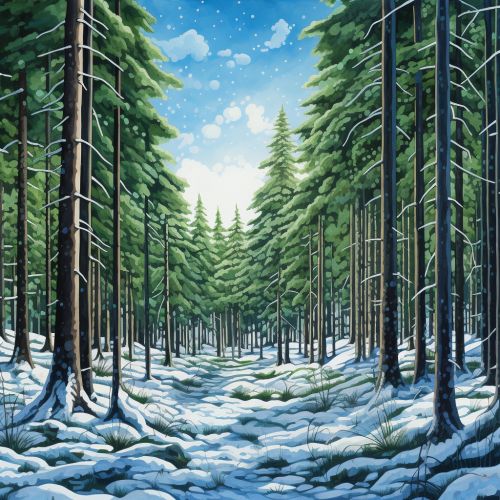Taiga
Introduction
The Taiga or boreal forest is the world's largest terrestrial biome. It extends across North America, Europe, and Asia, from Alaska to Japan, and from Scandinavia to the northern parts of Russia. The taiga is characterized by coniferous forests, consisting mostly of pines, spruces, and larches. The climate is cold, with long, harsh winters and short, cool summers. The taiga is home to many species of animals and plants that have adapted to its harsh conditions.
Geography and Climate
The taiga biome is found in the high northern latitudes, between the tundra and the temperate forest, from about 50°N to 70°N. The climate of the taiga is characterized by long, cold winters and short, cool summers. The average temperature is below freezing for six months of the year. The winter temperature can drop as low as -65°F (-54°C), while the summer temperature can reach as high as 70°F (21°C). The annual precipitation, including melting snow, is 15 to 40 inches (38 to 102 cm), most of which falls as rain in the summer.


Flora and Fauna
The taiga is dominated by coniferous trees, mainly pines, spruces, and larches. These trees have adapted to the harsh conditions of the taiga by developing needle-like leaves, which reduce water loss, and a conical shape, which helps shed snow. The understory of the taiga is typically sparse, with few species of shrubs and herbs, such as bilberry and lingonberry.
The taiga is home to a variety of animal species. Large mammals, such as moose, elk, and brown bear, are common. The taiga is also an important habitat for many bird species, including owls, hawks, and woodpeckers. Smaller mammals, such as squirrels, hares, and voles, are also abundant. The taiga is home to several species of insects, including mosquitoes, which are abundant in the summer.
Human Interaction
Human interaction with the taiga has been primarily through logging, mining, and oil and gas extraction. These activities have led to significant deforestation and habitat loss. Climate change is also a major threat to the taiga, as rising temperatures are expected to shift the taiga biome northward, leading to a loss of habitat for many species.
Conservation
Efforts to conserve the taiga focus on protecting large areas of intact forest, promoting sustainable forestry practices, and mitigating the impacts of climate change. Protected areas, such as national parks and wildlife reserves, play a crucial role in conserving the biodiversity of the taiga. Sustainable forestry practices, such as selective logging and replanting, can help maintain the health and productivity of the taiga.
